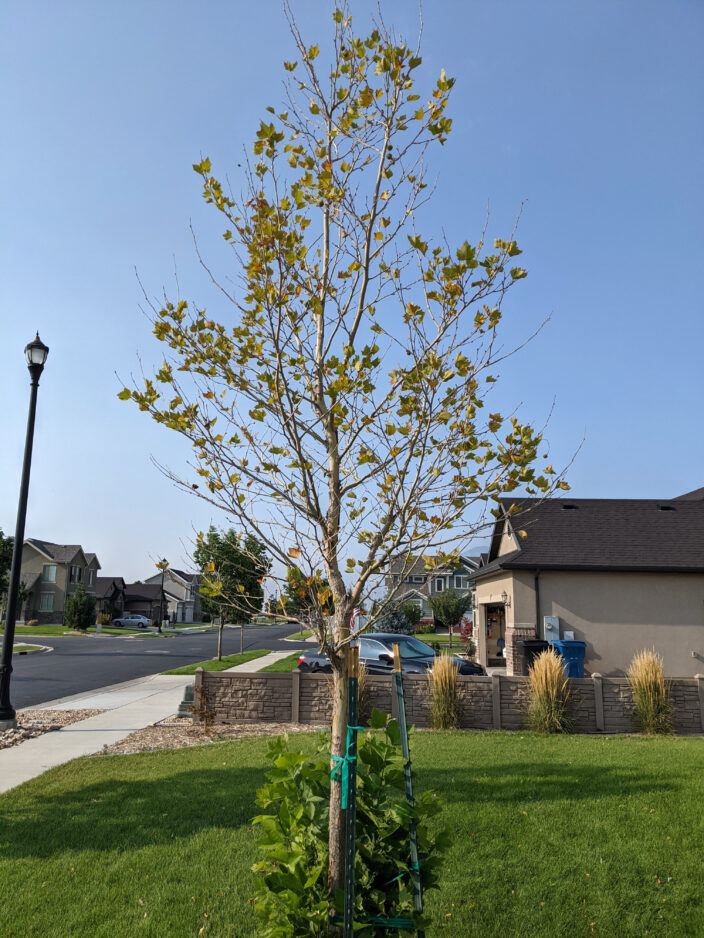Garden Help Desk: Suckers! How to care for damaged trees with new growths
- This young sycamore’s leaves were damaged by insects and it dropped most of its leaves early. Normally, suckers are removed when they are noticed, but the leaves on the suckers at the base of the trunk are healthy and producing energy for this tree, not using energy.
- Trunk damage by mowers and trimmers affects the health of trees and can shorten their lives. Always keep at least 2 to 3 feet of clearance between tree trunks and lawns.
- It’s normal for trees and shrubs to drop their leaves early when there has been insect or disease damage. A thorough fall cleanup is always a good idea.
Question: I have a young sycamore tree. I planted it a few years ago and this year it has sycamore scale. At this point, the leaves are falling off and the tree is sending up growths from the bottom. Any advice on how I should treat this? Do I let the growths continue so that the tree has enough carbon to grow leaves next year, or do I cut them so that they don’t pull all the nutrients from the rest of the tree? Or something else entirely?
Answer: It’s normal for leaves to drop early from trees and shrubs when they’ve been damaged by disease or insects during the season, so you’d expect the early leaf drop from your tree.
It’s a common misconception that healthy leaves “take away” the energy from roots, fruits and vegetables in our garden. Those healthy green leaves on the suckers aren’t taking nutrients, they’re making nutrients.
There are very few leaves on the upper tree and none of them look healthy. Those leaves will drop early, too, but until they do, they’ll be using more resources than they can produce. Right now, the green leaves on the suckers are the only good source of carbohydrates for the tree. The tree will store that energy for the winter and use it to leaf out and grow next spring.
Leave the suckers alone for now and then sometime after all the leaves have dropped, but before your landscape starts waking up in the very early spring, you can move away enough soil around the suckers to expose the roots they’re growing from and cut them off from the roots. Don’t leave any sucker stubs.
For now, take good care of your tree. Make sure you water the area with the tree deeply, but infrequently, from now on. Established trees should be watered deeply, but not more than once a week during the summer and less often in the spring and fall. Your tree is in the lawn, so it’s important to water your lawn deeply, but as infrequently as it will tolerate. Most lawns in our area can go at least three days between waterings if they’re watered deeply, and that would be a good compromise between your tree and your lawn.
Your tree will also benefit from having a wider lawn-free area around the trunk to reduce the risk of mower and trimmer damage. Keep grass at least 2 to 3 feet away from the trunk.
Question: I was doing yard work really early in the morning (just before dawn) a few weeks ago and sprayed my lawn with weed killer without really looking at the label. It wasn’t lawn weed killer; it was Ground Clear. All the weeds died, but so did my grass. I want to replant my lawn as soon as the weather is a little cooler so that I don’t have a muddy yard this winter. When is the best time to replant my lawn?
Answer: Grass seed germinates best with mild, warm temperatures and drier conditions so that the soil drains easily, so now is a good time to start a new lawn from seed. Starting you lawn in late summer also gives the grass seedlings time to grow and mature enough to overwinter in our area. But starting a new lawn now won’t work for you because of the herbicide you used.
GroundClear and similar products don’t just kill the weeds you spray, they prevent new weeds from growing. The chemicals aren’t picky about what they’ll kill and don’t know the difference between the weeds you hate and the plants you love. The GroundClear label states that it will prevent vegetation for up to one year, so you’ll be waiting for a while before you can replant your lawn.
Applying pesticides in the dark is like taking medicine in the dark. You can’t be sure you’ve picked up the right container if you can’t clearly see the label. Always look before you spray! Read the label and make sure you have the right product, that it will do what you want it to do and that there won’t be unintended consequences.
If you want to reduce mud problems in your yard this winter, you’ll be better off leaving the dead lawn in place. The dead grass will help to hold the soil in place and keep it covered for at least part of the winter.
Next spring you can do your soil preparation — getting a soil test, adding compost, upgrading or repairing your sprinkler system, and getting everything leveled and ready to go. Then you can start planting some small test plots every month or two. Once you see a test plot growing and thriving, you’ll know you can invest your time and money into replanting your entire yard.








